There are a range of grants available for heritage projects and programs at both NSW and Commonwealth Level. This page will provide information from time to time on different grants that are available for either Warangesda and/or other heritage places.
NSW Heritage Grants:
heritage-grant-guidelines-aboriginal-cultural-180524
The Waddi Housing and Advancement Corporation in Darlington Point has been successful in securing funding to build a new Cultural Garden & Heritage Centre which will showcase aspects of Warangesda. Details of the funding announcement is provided. For further information on this project contact the Waddi Housing and Advancement Corporation on (02) 69684390 or email: info@waddihousing.com
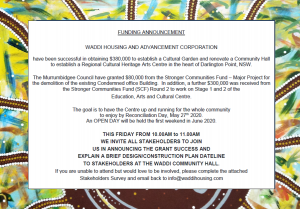
A 'Stakeholder Survey' for the Cultural Garden and Heritage Education Art Gallery Centre is open during the period July 2019 to May 2020. Please download or print the below link, complete the form and return to the Waddi Housing and Advancement Corporation.
Stakeholder Survey for Cultural Garden and Heritage
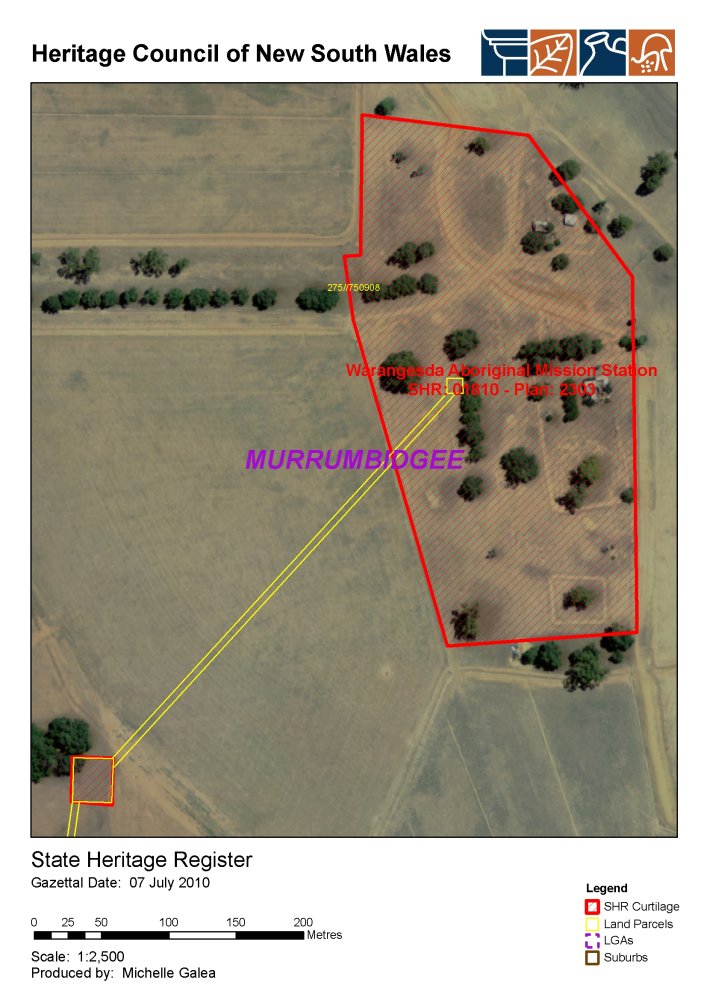
Warangesda State Heritage Listing Boundary
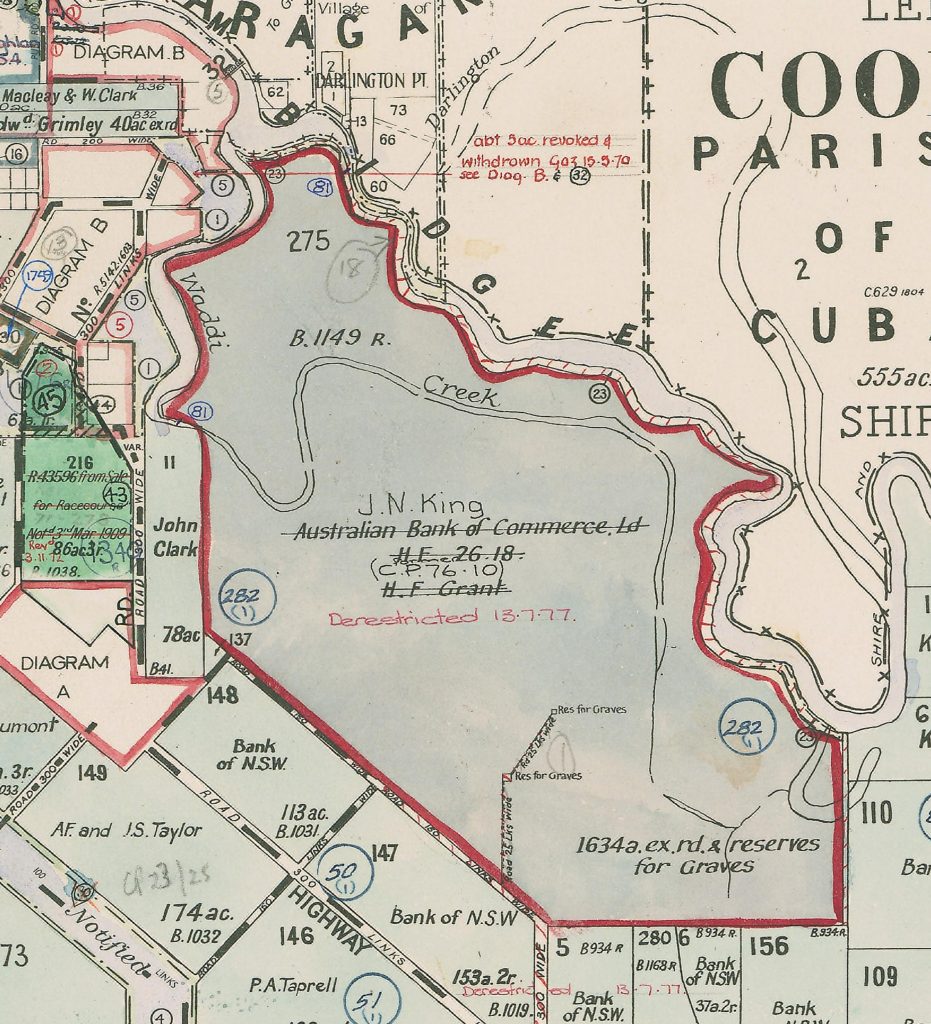
Boundary of the Warangesda Station
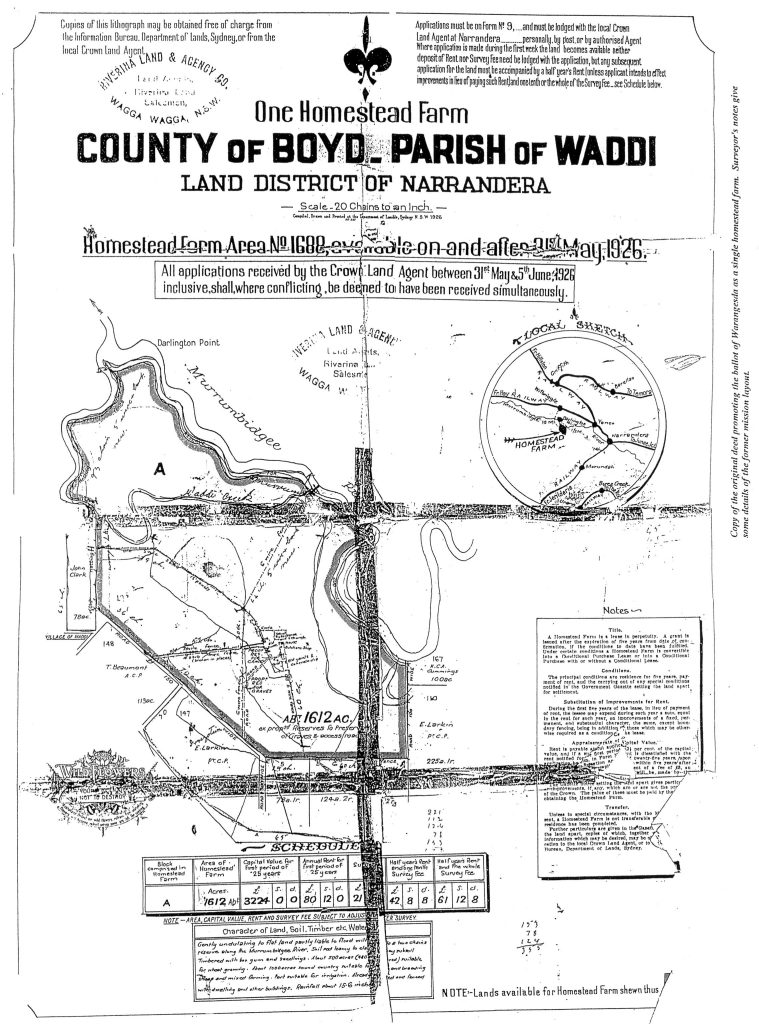
Parish map showing Warangesda Station
Over many years those associated with the Mission Site have worked towards the site being NSW State Heritage listed. The push for the heritage listing began in the 1990's. There were a number of applications that were submitted to the NSW Heritage Office and it wasn't until 2010 that the listing was finalised and approved by the NSW Heritage Council. The following information relates that that listing.
Warangesda State Heritage Listing – 9th July 2010:
http://www.environment.nsw.gov.au/heritageapp/ViewHeritageItemDetails.aspx?ID=5055095
Warangesda Mission gets heritage listing:
http://www.abc.net.au/news/2010-07-12/warangesda-mission-gets-heritage-listing/900478
There were a number of factors that contributed to the final listing being successful. The landowners, the King family, had to agree with the listing as there are many requirements that had to be met by them as the land owners. These conditions can often impede the general running of their property but approval was given.
There was a celebration for the listing and an opportunity to visit the site in 2010. There were a number of people interviewed on the day of the official ceremony and those interviews have been captured in a video of the event. The Heritage listing was an opportunity for the wider community to acknowledge the survival of Aboriginal people who once lived on the mission. The heritage listing acknowledged the significance of the site especially the school which was the first public school in rural NSW. Warangesda was the model that was used for Cootamundra Girls Home as well as Kinchela Boys Home. Warangesda adopted the practice of teaching the children to become domestic servants and farm workers.
Any artefacts including bottles, crockery and other bric-a-bac from that period are considered protected items and should not be removed at any time. The various buildings have not been maintained and have began to fall further into disrepair. Ideally, the buildings should have significant works undertaken given their historical and cultural importance.
WARNING: ABORIGINAL AND TORRES STRAIT ISLANDER [VIEWERS, LISTENERS, READERS] ARE ADVISED THAT THIS WEBSITE CONTAINS IMAGES AND VOICES OF PEOPLE WHO ARE NOW DECEASED.
This website is best viewed through Google Chrome rather then Internet Explorer.
The Warangesda Website is in early development and additional information will be added over time. This website is designed to bring together a range of public information on the former Warangesda Aboriginal Mission based at Darlington Point in the Riverina Region of NSW. If you have any information that could be added to this website please contact one of the Aboriginal organisations on the Contact Page.
The website is part of the 'Warangesda Exhibition and History Project' funded by the Australian Government - Department of the Prime Minister and Cabinet under it's Indigenous Advancement Strategy (IAS) - Culture and Capability Programme. Funding was provided to the Leeton & District Local Aboriginal Land Council to administer the project.
HISTORICAL INFORMATION ABOUT WARANGESDA:
Philippa Scarlett, 1994. Indigenous Histories - Warangesda Daily Life and Events 1880-1924
https://indigenoushistories.com/warangesda/
Warangesda on Wikipedia
https://en.wikipedia.org/wiki/Warangesda_Aboriginal_Mission
John Harris, 2004. On John Brown Gribble (1847-1893). Evangelical History Association of Australia
http://webjournals.ac.edu.au/ojs/index/php/ADEB/article/view/1192/1189
Leeton & District Local Aboriginal Land Council - Warangesda
http://www.ldlalc.com.au/significant-sites/pellentesque-habitant-0
Warangesda Aboriginal Mission & Station - Facebook Site
https://www.facebook.com/Warangesda-Aboriginal-Mission-Station-736757123064257/
Peter Kabaila has undertaken a number of projects on Wiradjuri Country including producing a number of books that record historical events that have shaped the people who now populate this Country. Peter's association with Warangesda Aboriginal Mission and Station has been over many decades. Peter has collected and recorded many items from the site that have been previously held in a number of private collections. The maps of the area are based on historical maps in conjunction with personal recollections of various people who have had an association with the Mission site. This research has enabled him to provide a collection of maps that can be held for perpetuity and give a sense of place for those who are connected either through being a descendant of the original Aboriginal people who lived and worked on the Mission.
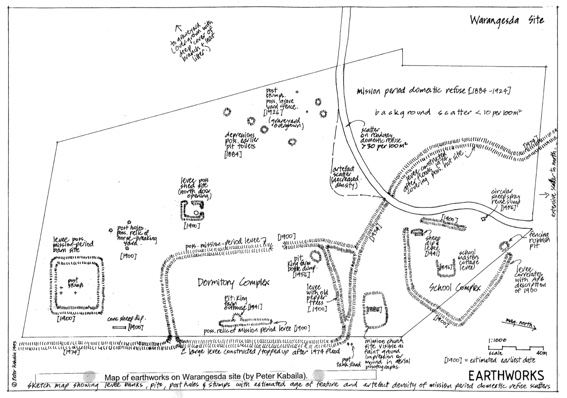
Peter has been very generous with his time and support of the various projects that have been undertaken such as the Heritage listing in 2010. For many of the descendants the listing was important to have some protection on the site but was disappointing as the site was listed as a ruin. The detailed maps produced by Peter were a substantial undertaking that record key points of the site. There are noted discrepancies which is indicative of these works. Overall though the maps and the archaeological works undertaken provide clear evidence of the importance of the area and why the impact of mission life reverberates to this day. Peter's work captures the overwhelming changes to previous cultural safety that was enjoyed by Aboriginal people before invasion and the systematic genocide of the Wiradjuri people and other nations in neighbouring countries.
It is important that these maps and the archaeological works undertaken by Peter are used in conjunction with other historical information that is available in regards to the Mission Site. Given the era there are many factual accounts available to use in conjunction with these maps. It was a sign of the times how and why data was collected on the Aboriginal people who were ruled by policies that were subjective of the invaders.
Click to see the plan of the 1880 layout of Warangesda (by Peter Kabaila).
Click to see the Map of Earthworks on the Warangesda site (by Peter Kabaila).